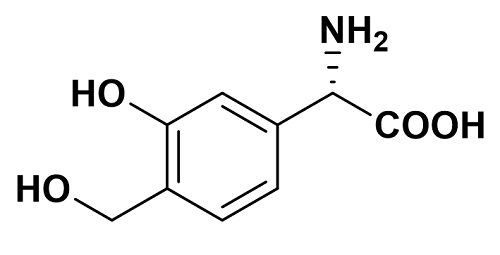Immunomodulator Forphenicinol
Date:December 22 2020Web Page No:90016
Forphenicinol does not inhibit alkaline phosphatase, binds to cell surface enzymes, and exhibits biological activities such as enhanced delayed hypersensitivity, enhanced macrophage phagocytosis, antitumor effects on transplanted tumors, and enhanced resistance to Pseudomonas aeruginosa infection in mice, while being extremely low toxicity 1, 2). Forphenicinol was developed from Forphenicine (#09636), an alkaline phosphatase inhibitor isolated from the broth of actinomycetes. * This product is for research use only.

Specification
| CAS# | 71522-58-2 |
|---|---|
| Molecular Formula | C9H11NO4 |
| Molecular Weight | 197.190 |
| Source | Synthetic derivative of forphenicine |
| Purity | > 90% (HPLC) |
| Solubility | Soluble in MeOH, H2O Insoluble in Hexane |
Application Note
Forphenicinol is a synthesized derivative of forphenicine, the inhibitor of alkaline phosphatase produced by Streptomyces 3, 4).
- Forphenicinol augments delayed-type hypersensitivity (DTH) response induced by both sheep red blood cells (SRBC) or oxazolone by oral administration of 1-100 μg/mouse 1).
- The treatment with forphenicinol restores DTH in mice immuno-suppressed by cyclophosphamide to normal response at 100 μg/mouse 1).
- Phagocytosis by peritoneal macrophages is enhanced in vivo and in vitro 1).
- Forphenicinol is effective in increasing the production of the colony-forming unit in culture (CFU-C) in the presence of colony stimulating factor and partially prevents the reduction of leucocyte counts caused by mitomycin C 1).
- Ehrlich carcinoma is suppressed by treatment with 0.08-0.31 mg/kg/day of forphenicinol given for 5-10 days after tumor inoculation but it does not show antitumor effect in larger doses 2).
- IMC carcinoma is also suppressed by treatment with 0.5-5 mg/kg/day given for 5-8 days after the inoculation 2).
- Forphenicinol enhances the antitumor effect of 6-mercaptopurine, aclacinomycin or cyclophosphamide 2).
- Forphenlcinol shows a protective effect on mouse model of Pseudomonas aeruginosa infection 2).
- When forphenicinol was orally administered to patients with chronic respiratory tract infections, infectious episodes and suppressor T cells reduced. It suggests that it is useful 5, 6).
* Biological activity of the product was not verified. The values shown above were cited from the references.
Reference
- Ishizuka M., et al., J. Antibiot., 35 (8), 1,042~1,048 (1982). [PMID:7142005]
- Ishizuka M., et al., J. Antibiot., 35 (8), 1,049~1,054 (1982). [PMID:7142006]
- Morishima H., et al., J. Antibiot., 35 (11), 1,500~1,506 (1982). [PMID:7161189]
- Aoyagi T., et al., J. Antibiot., 31 (3), 244~246 (1978). [PMID:348665]
- Matsumoto K., et al., Kansenshogaku Zasshi., 59 (7), 766~776 (1985). [PMID:3932556]
- Yoshimura K., et al., Kansenshogaku Zasshi., 59 (10), 996~1,004 (1985). [PMID:3936891]

[Date : January 11 2026 00:08]
| Detail | Product Name | Product Code | Supplier | Size | Price | ||||||||||||||||||||||||||||||
|---|---|---|---|---|---|---|---|---|---|---|---|---|---|---|---|---|---|---|---|---|---|---|---|---|---|---|---|---|---|---|---|---|---|---|---|
|
Forphenicinol, Immunomodifier DatasheetThis may not be the latest data sheet. |
09637 | IMCInstitute of Microbial Chemistry | 1 mg | $500 | |||||||||||||||||||||||||||||||
|
|
|
||||||||||||||||||||||||||||||||||
[Date : January 11 2026 00:08]
Forphenicinol, Immunomodifier
DatasheetThis may not be the latest data sheet.
- Product Code: 09637
- Supplier: IMC
- Size: 1mg
- Price: $500
| Description |
M.W.: 197.190 Purity : >98% (HPLC) Molecular Formula : C9H11NO4 Solubility : Soluble in MeOH, DMSO, and H2O Insoluble in hexane. Forphenicinol is a synthesized derivative of forphenicine, the inhibitor of alkaline phosphatase produced by Streptomyces. The compound does not have inhibitory activity to alkaline phosphatase. It exhibits biological activities such as enhanced delayed hypersensitivity, enhanced macrophage phagocytosis, antitumor effects on transplanted tumors, and enhanced resistance to Pseudomonas aeruginosa infection in mice, while being extremely low toxicity. |
||
|---|---|---|---|
| Storage | -20°C | CAS | 71522-58-2 |
| Link | |||
CONTACT
export@funakoshi.co.jp
- ※Prices on our website are for your reference only. Please inquire your distributor for your prices.
- ※Please note that Product Information or Price may change without notice.
